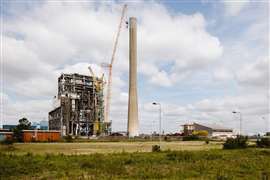What are the long-term prospects for India’s construction equipment market?
04 June 2025
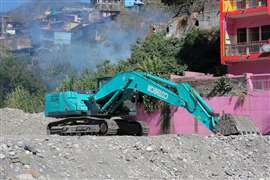 A turquoise Kobelco crawler excavator in Rishikesh, Uttarakhand, India (Image: d_odin via AdobeStock - atock.adobe.com)
A turquoise Kobelco crawler excavator in Rishikesh, Uttarakhand, India (Image: d_odin via AdobeStock - atock.adobe.com)
For decades, the construction industry viewed the Indian market as a “when” not an “if” regarding maturity. The moment may be imminent, Mitchell Keller reports
India is entering a new era of infrastructure development, with government-backed investment accelerating across transport, energy and urban sectors.
This new reality has construction contractors and construction equipment manufacturers salivating at the possibilities; with a population surpassing 1.4 billion and a rapidly expanding economy, the need for modern, large-scale infrastructure in India has become urgent.
The ambition of the country’s recent programmes is setting the stage for major changes in how – and where – construction work is done.
India’s infrastructure overhaul
Driving the modern construction renaissance for the country is the Union Budget for 2025–26; the Indian government allocated ₹11.21 lakh crore (about US$133 billion) for infrastructure capital expenditure – a record.
That figure represents 3.4% of the country’s Gross Domestic Product (GDP) and signals a long-term commitment to modernisation across public works, logistics and utilities.
Notably, the rail sector saw a 10% budget increase, with funding directed toward modernising more than 1,000 stations, expanding the high-speed network, and advancing electrification. Highways spending also rose by 7%, supporting major initiatives like the Bharatmala Pariyojana programme, which aims to overhaul India’s national road connectivity.
A large share of this spending is tied to the ongoing PM Gati Shakti Master Plan, a national initiative to unify and coordinate infrastructure development.
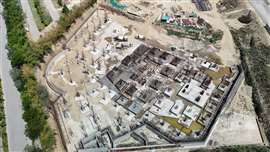 A housing development under construction in India (Image: Sharad via AdobeStock - stock.adobe.com)
A housing development under construction in India (Image: Sharad via AdobeStock - stock.adobe.com)
At the urban level, city-focused infrastructure spending is also on the rise, with ₹7.4 trillion earmarked for urban development between 2024 and 2028. Key initiatives include metro expansion, housing, solid waste management, and city-wide upgrades under India’s Smart Cities Mission. These projects are likely to support sustained demand for building materials, earthmoving machinery, and project-based contractor services.
According to recent analysis by Off-Highway Research, developed in partnership with advisory firm abcg, the Indian construction equipment market is poised for long-term growth. “It is the largest equipment market outside of China and the most attractive growth opportunity globally,” the report states.
However, it also notes that while demand is surging, the country remains heavily reliant on low-cost labour – presenting both an opportunity and a challenge for OEMs seeking to grow their market share.
Contractors and OEMs often require direct evidence of efficiency gains before adopting new technology, and price sensitivity remains high across sectors. Speaking at Bauma, several major OEMs shared with International Construction (ICON) that mirrored video-demonstrations – illustrating the time and labour savings of executing work with modern machines compared with manual labour – are vital in selling solutions to the Indian market.
The analysis also highlights a key tension: while global OEMs are expanding in India, Chinese manufacturers are proving highly competitive, particularly in sectors like earthmoving and mining. This growing competition is reshaping market dynamics, pushing all players to adapt their local strategies and product offerings.
As abcg’s analysis notes, “For OEMs, succeeding in India means going beyond price; it requires local manufacturing, custom-fit machines, robust aftersales service, and most importantly, a demonstration of tangible value.”
Chinese OEMs
As India’s infrastructure spending accelerates, global equipment manufacturers are repositioning themselves for long-term growth, and Chinese OEMs are among the most aggressive in expanding their presence.
According to Off-Highway Research and abcg, LiuGong and Sany have emerged as key challengers to established global players, competing not only on price but on local manufacturing capabilities and sophisticated aftersales support.
“Chinese OEMs are getting better at meeting the specific needs of Indian customers,” the report notes. “Their machines are often perceived as offering better value for money, particularly in applications where durability and reliability are not the primary concern.”
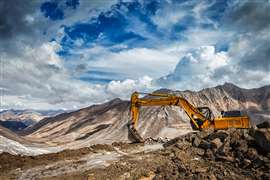 An excavator does road construction work in the Himalayas (Image: Dmitry Rukhlenko via AdobeStock - stock.adobe.com)
An excavator does road construction work in the Himalayas (Image: Dmitry Rukhlenko via AdobeStock - stock.adobe.com)
“We started the India business from 2002 and we built the first factory in 2006,” LiuGong Chairman Zeng Guang’an tells International Construction at Bauma 2025. “Now we are building the second factory in India. The market is booming… mining, small jobs and everything.”
That local investment has gone hand-in-hand with electrification. LiuGong introduced battery-electric equipment in India three years ago, and Zeng says uptake is growing.
“Indian customers are very smart and very sensitive to the cost of operations,” he says. “BEV... for the wheel loaders can reduce up to 70% of the operation cost. So that’s big savings... especially in India because the oil prices are very high.”
Another China-based OEM, Sany, recently expanded its Indian footprint by opening another Sales, Service, Spares outlet. Sany says this means every customer in India is now within 150km of a service centre, a critical factor in a market where post-sale support can be the deciding factor in purchases. The OEM now has 42 dealers across the country.
Off-Highway Research notes that while these firms still trail domestic leaders in total volume, their growth trajectory is steep, and their aggressive pricing and expanding service networks will likely continue to reshape the competitive landscape.
Local roots, electric ambitions
Other OEMs are taking note of these same trends, adjusting both their go-to-market strategies and their messaging in response to India’s mix of opportunity and pragmatism.
UK-based JCB has long been a key player in India’s construction equipment industry. In early 2025, JCB India unveiled a new range of CEV Stage 5-compliant machines at the Bharat Construction Equipment Expo.
This lineup includes backhoe loaders, telehandlers, skid steer loaders, compactors, and wheeled loaders, with each designed to meet the Indian government’s latest emissions and safety regulations.
US-based Caterpillar has more than 50 years of operations in the country and has supported major projects ranging from the Bhakra Nangal Dam to the Atal Tunnel and the Purvanchal Expressway. Its footprint includes manufacturing facilities in Tiruvallur, Hosur, and Aurangabad, along with R&D operations in Chennai.
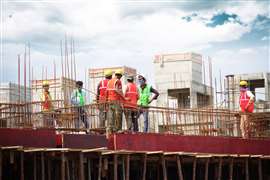 Construction workers at a site in India (Image: prk via AdobeStock - stock.adobe.com)
Construction workers at a site in India (Image: prk via AdobeStock - stock.adobe.com)
In 2024, Caterpillar introduced its ‘Services Commitment’ programme at Bauma Conexpo India, aimed at enhancing Customer Value Agreements (CVAs) by guaranteeing service response and parts availability within agreed timeframes.
Meanwhile, Bobcat is exploring new avenues for cross-market equipment strategy, but from India into North America. Speaking to ICON at World of Concrete 2025, Ryan Saunders, Bobcat product specialist, notes that Bobcat’s B760 backhoe loader – recently launched in North America – is derived directly from a successful platform already in use in India.
“This machine, the B760, it’s a popular model in other parts of the world,” said Saunders. “We’ve done really well in India, Latin America, and parts of Asia and Europe, and we’re bringing it over [to North America] and we’re optimistic.”
Saunders described the machine as a versatile, cost-efficient tool particularly well-suited to municipalities and mid-sized contractors. Its multi-tool usefulness, in particular, was seen as a great advantage for small- and mid-sized India-based outfits.
While some North American models tend to prioritise digital features and advanced automation, Bobcat’s India-derived B760 remains relatively basic; a deliberate choice aimed at maximising affordability, value and versatility for owners and dealers.
The move illustrates that India is no longer just a destination for sales and assembly. Increasingly, it is becoming a proving ground for global product development, especially in cost-conscious, high-utility machine categories where value and durability are paramount.
Japan-based Hitachi Construction Machinery is also ramping up its long-term commitment to India, but in the avenue of research and development (R&D).
The company announced the creation of a new product development centre in Hubballi, Karnataka, which will serve as a hub for design, simulation and advanced engineering.
Building for India, from India
It’s not just international OEMs ramping up investment – homegrown manufacturers are also seizing the moment.
Action Construction Equipment (ACE) is one of several Indian OEMs actively positioning itself as an alternative to Chinese suppliers amid shifting trade dynamics and calls for diversified sourcing. ACE’s portfolio includes mobile and truck-mounted cranes, tower cranes, crawler cranes, piling rigs, backhoe loaders, road equipment, and vibratory rollers.
According to sister publication Construction Europe, ACE is leveraging recent disruptions in US-China trade to build momentum in export markets. Ajay Malik, the company’s head of international business says, “There is a shift in the way people view India. We are being seen as a reliable partner for quality manufacturing, and that’s translating into new export opportunities.”
The company says its growth aligns with the Make in India initiative, which promotes local manufacturing with export capability. Malik noted that a combination of government policy support and global demand for equipment diversification has created a ripe environment for Indian OEMs to scale internationally.
This moment signals a transition: India is not just a target for OEM expansion, it’s becoming an exporter of construction equipment knowledge, talent, and hardware.
India’s construction sector stands at an inflection point. What was once a “next big thing” market has become a centre of gravity in the global equipment landscape, where infrastructure investment is high, policy support is active, and manufacturers are learning that Indian success demands local fluency.
The years ahead will test how well that lesson holds. Electrification, digitalisation, and AI-assisted workflows are all advancing globally – but India’s adoption curve will remain shaped by unique local pressures: labour dynamics, budget constraints, regional diversity, and the relentless demand for uptime.
Yet those same pressures may also foster innovation. As OEMs develop machines that are simpler, smarter, and more durable for Indian conditions, those designs could soon circle back into global portfolios.
Likewise, the rise of Indian OEMs on the world stage suggests that India won’t just be a proving ground. If the next decade of construction is about building for scale, speed and resilience, few places are better positioned than India to show how it’s done.
‘World’s highest’ 3D-printed structure
What is claimed to be the world’s highest on-site 3D printed structure has been created by Simpliforge Creations and IIT Hyderabad in collaboration with the Indian Army.
The structure was printed in 14 hours using Simpliforge’s robotic 3D printer, which was deployed and commissioned in under 24 hours.
Simpliforge’s CEO Dhruv Gandhi said, “Reduced oxygen levels impaired power efficiency and human performance. Low humidity and high UV radiation impacted material integrity – but our systems delivered a robust structure in just five days.”
Operating at high altitudes with thermal extremes required specially engineered concrete.

STAY CONNECTED


Receive the information you need when you need it through our world-leading magazines, newsletters and daily briefings.
CONNECT WITH THE TEAM










